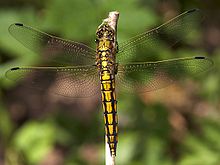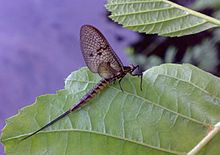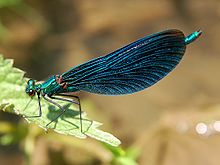- Neuroptera in the 10th edition of Systema Naturae
-
Main article: Insecta in the 10th edition of Systema Naturae
In the 10th edition of Systema Naturae, Carl Linnaeus classified the arthropods, including insects, arachnids and crustaceans, among his class "Insecta". Insects with net-veined wings were brought together under the name Neuroptera.
Contents
Libellula (dragonflies & damselflies)
The Beautiful Demoiselle was named Libellula virgo in 1758.
 The Black-tailed Skimmer was named Libellula cancellata in 1758.
The Black-tailed Skimmer was named Libellula cancellata in 1758.
- Libellula quadrimaculata – Four-spotted Chaser
- Libellula flaveola – Yellow-winged darter
- Libellula vulgata – Vagrant Darter
- Libellula rubicunda – Leucorrhinia rubicunda
- Libellula depressa – Broad-bodied Chaser
- Libellula vulgatissima – Gomphus vulgatissimus
- Libellula cancellata – Black-tailed Skimmer
- Libellula aenea – Downy Emerald
- Libellula grandis – Brown Hawker
- Libellula juncea – Common Hawker
- Libellula forcipata – Onychogomphus forcipatus
- Libellula fasciata & Libellula americana – Zenithoptera fasciata
- Libellula umbrata – Erythrodiplax umbrata
- Libellula dimidiata – Diastatops dimidiatus
- Libellula chinensis – Neurobasis chinensis
- Libellula virgo – Beautiful Demoiselle
- Libellula puella – Azure Damselfly
Ephemera (mayflies)
 The mayfly Ephemera vulgata was named in 1758.
The mayfly Ephemera vulgata was named in 1758.
- Ephemera vulgata [2]
- Ephemera bioculata & Ephemera culiciformis – Baetis fuscatus [2][3]
- Ephemera horaria – Caenis horaria [2]
- Ephemera mutica – Alainites muticus [2]
- Ephemera vespertina – Leptophlebia vespertina [2]
Phryganea (caddisflies)
- Phryganea phalaenoides – Semblis phalaenoides
- Phryganea striata – Oligotrichia striata
- Phryganea grisea – Limnephilus griseus
- Phryganea grandis
- Phryganea rhombica – Limnephilus rhombicus
- Phryganea bimaculata – Neureclipsis bimaculata
- Phryganea flavilatera – Sialis flavilatera
- Phryganea bicaudata – Diura bicaudata
- Phryganea nigra – Mystacides nigra
- Phryganea longicornis – Mystacides longicornis
- Phryganea filosa – Oecetis ochracea
- Phryganea waeneri – Tinodes waeneri
- Phryganea albifrons – Athripsodes albifrons
- Phryganea bilineata – Athripsodes bilineatus
- Phryganea nebulosa – Taeniopteryx nebulosa
- Phryganea fusca – Leuctra fusca
- Phryganea flava – Limnephilus centralis
Hemerobius (lacewings)
- Hemerobius perla & Hemerobius chrysops – Chrysopa perla [5][6]
- Hemerobius phalaenoides – Drepanopteryx phalaenoides [5]
- Hemerobius formicaleo & Hemerobius formicalynx – Myrmeleon formicarius [7]
- Hemerobius testaceus – Coptotermes testaceus [8]
- Hemerobius marginatus
- Hemerobius humulinus [9]
- Hemerobius sexpunctatus [10]
- Hemerobius flavicans [11]
- Hemerobius lutarius – Sialis lutaria [5]
- Hemerobius speciosus – Palpares speciosus [12]
- Hemerobius albus – Chrysopidia ciliata [13]
- Hemerobius cornutus – Corydalus cornutus [14]
- Hemerobius pedicularius [15]
Panorpa (scorpionflies)
- Panorpa communis [16]
- Panorpa germanica [16]
- Panorpa coa – Nemoptera bipennis [17]
Raphidia (snakeflies)
- Raphidia ophiopsis [18]
Footnotes
References
- ^ Martin Schorr, Martin Lindeboom & Dennis Paulson. "World Odonata List". University of Puget Sound. http://www.pugetsound.edu/academics/academic-resources/slater-museum/biodiversity-resources/dragonflies/world-odonata-list/. Retrieved August 31, 2010.
- ^ a b c d e "Listes faunistique des Ephémères [Faunistic list of the Ephemeroptera]" (in French) (PDF). Office pour les Insectes et leur Environnement. http://www.opie-benthos.fr/opie/pdf/119_pagesdynadocs4bf1b34cb79a1.pdf. Retrieved September 1, 2010.
- ^ A. Poppels & M.Kalniņš (November 11, 2002). "Viendienītes – Ephemeroptera". Entomological Society of Latvia. http://leb.daba.lv/Ephemeroptera.htm. Retrieved September 1, 2010.
- ^ Ralph W. Holzenthal, Roger J. Blahnik, Aysha L. Prather & Karl M. Kjer (2007). "Order Trichoptera Kirby, 1813 (Insecta), Caddisflies" (PDF). Zootaxa 1668: 639–698. http://www.azoresbioportal.angra.uac.pt/files/publicacoes_Holzenthal_Trichoptera.pdf.
- ^ a b c Colin L. Plant (1994) (PDF). Provisional atlas of the lacewings and allied insects (Neuroptera, Megaloptera, Raphidioptera and Mecoptera) of Britain and Ireland. Institute of Terrestrial Ecology. ISBN 1-870393-18-X. http://nora.nerc.ac.uk/7445/1/Lacewings26allied.pdf.
- ^ Roberto Antonio Pantaleoni (2005). "Interpretation of Achille Costa’s data on Neuropterida" (PDF). Bulletin of Insectology 58 (1): 71–92. http://www.bulletinofinsectology.org/pdfarticles/vol58-2005-071-092pantaleoni.pdf.
- ^ Mark Swanson. "Zoological History". Antlion Pit. http://www.antlionpit.com/history.html. Retrieved August 31, 2010.
- ^ "Genus Coptotermes Wasmann". Catalog of the Termites of the New World. Universidade de Brasília. October 3, 2000. http://vsites.unb.br/ib/zoo/docente/constant/catal/gen/coptot.htm. Retrieved August 31, 2010.
- ^ Hemerobius humulinus at the Encyclopedia of Life
- ^ Hemerobius sexpunctatus at the Encyclopedia of Life
- ^ Hemerobius flavicans at the Encyclopedia of Life
- ^ Norman D. Penny, Phillip A. Adams & Lionel A. Stange (1997). "Species catalog of the Neuroptera, Megaloptera and Raphidioptera of America north of Mexico". Proceedings of the California Academy of Sciences 50 (3): 39–114. http://www.archive.org/details/proceedingsofcal0450cali.
- ^ "Chrysopidia ciliata (Wesmael, 1841)". Neuropterida Species of the World. http://ecat-dev.gbif.org/usage/111939645. Retrieved August 31, 2010.
- ^ Atilano Contreras-Ramos (November 15, 1997). "Corydalus". Tree of Life Web Project. http://tolweb.org/Corydalus. Retrieved August 31, 2010.
- ^ Hemerobius pedicularius at the Encyclopedia of Life
- ^ a b Evelyne Carrières (2001). "Revision and additions to the list of lacewings (Megaloptera, Neuroptera, Raphidioptera) and scorpion flies (Mecoptera) of Luxembourg" (PDF). Bulletin de la Société des Naturalistes Luxembourgeois 102: 91–96. http://www.snl.lu/publications/bulletin/SNL_2001_102_91_96.pdf.
- ^ Paul Foster (2007). "The Gibraltar collections: Gilbert White (1720–1793) and John White (1727–1780), and the naturalist and author Giovanni Antonio Scopoli (1723–1788)". Archives of Natural History 34 (1): 30–46. doi:10.3366/anh.2007.34.1.30.
- ^ Raphidia ophiopsis at the Encyclopedia of Life
List of species Mammalia, Aves, Amphibia, Pisces, Insecta (Coleoptera, Hemiptera, Lepidoptera, Neuroptera, Hymenoptera, Diptera, Aptera), VermesCategories:- Systema Naturae
- Animals described in 1758
Wikimedia Foundation. 2010.



